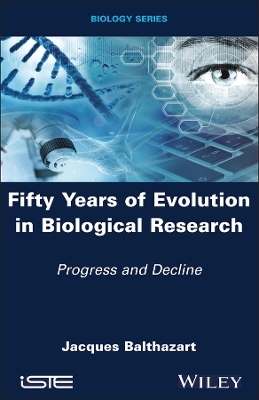
Fifty Years of Evolution in Biological Research
ISTE Ltd and John Wiley & Sons Inc (Verlag)
978-1-78630-878-8 (ISBN)
Fifty Years of Evolution in Biological Research presents a panorama of these different technical advances. However, at the same time, there has been an increase in the number of constraints on researchers, a monetization of research and a correlative pressure to continually publish in more prestigious journals. This has resulted in a certain degradation of the quality of research activity. This book analyzes this evolution and proposes solutions.
Jacques Balthazart is a biologist at the University of Liège, Belgium, who specializes in the control of reproductive behavior by sex hormones. He is the author of more than 500 scientific publications and several books of universal appeal dealing with sexual differences in behavior between men and women.
Preface ix
Acknowledgments xi
Introduction xv
Chapter 1 The Evolution of Techniques 1
1.1 Hormone assays 1
1.2 Techniques for the identification of steroid hormone action sites in the brain 3
1.3 Molecular biology and sequencing techniques 4
1.4 Controlled modification of gene expression 7
1.5 Techniques for temporarily modifying the activity of neurons 9
1.6 The rise of the computer and the personal computer 11
1.7 Appearance and development of the Internet 18
Chapter 2 The Profound Modification of Research Conditions 23
2.1 The evolution of research funding 24
2.2 The current funding situation: multiple sources of grants that are difficult to control 27
2.3 Ever-increasing constraints 29
2.3.1 Administrative tasks 29
2.3.2 Risk management 30
2.3.3 Animal welfare 33
Chapter 3 The Computer and its Consequences in Terms of Work 39
3.1 Changing the flow of scientific information 39
3.2 Scientific information management in laboratories 43
3.3 Data processing and preparation of scientific publications 46
Chapter 4 The Development of Publishing Giants and Open Access 51
4.1 The evolution of publishing houses 51
4.2 Open access: advantages and disadvantages 53
4.3 Unexpected consequence of open access: predatory journals 54
4.4 Reactions 58
Chapter 5 The Invention of Journal Impact Factors 63
5.1 The development of bibliometrics 63
5.2 Disadvantages and limitations 65
5.3 Use for the evaluation of researchers 68
Chapter 6 The Race to Publish and the Inadequate Methods of Evaluating Researchers 73
6.1 Increasingly abundant publications 73
6.2 Evaluation of researchers and grant applications 76
Chapter 7 The Consequences: An Overall Deterioration of Research Quality 81
7.1 The "bad", not very rigorous, science 81
7.1.1 Cognitive biases 82
7.1.2 The absence of randomization 83
7.1.3 The use of poorly validated techniques 85
7.1.4 The low power of the studies 86
7.1.5 Misuse of statistics and pseudoreplication 87
7.1.6 Probability hacking (P-hacking) 89
7.1.7 Inadequate presentation of results 91
7.2 Scientific fraud 95
7.2.1 Data selection 95
7.2.2 Partial or total data fabrication 96
7.2.3 Plagiarism 97
Chapter 8 The Scientific Community's Fight Against these Aberrations 101
8.1 Peer review 101
8.2 Post-publication criticism by the entire scientific community 103
8.3 Withdrawal of erroneous or fraudulent items 104
Chapter 9 Essential Modifications 109
9.1 The publication process and peer review 110
9.2 Pre-registration of studies 112
9.3 The reward system 114
Chapter 10 The Loss of Confidence in Science and the Return of the Irrational 117
10.1 A disaffection for science 118
10.2 The development of irrational beliefs 120
10.2.1 Creationism and the denial of evolution 120
10.2.2 Platism and the flat Earth theory 121
10.2.3 The rejection of Western medicine based on evidence 122
10.3 Social networks, fake news, post-truth and alternative truths 124
Chapter 11 The Solution(s) 129
11.1 Popularizing research results by researchers themselves 129
11.2 Develop critical thinking skills 130
11.3 Expanding an understanding of basic statistics to the general public 131
11.4 Controlling misinformation using social networks 134
Conclusion 137
References 141
Index 151
| Erscheinungsdatum | 19.09.2023 |
|---|---|
| Verlagsort | London |
| Sprache | englisch |
| Gewicht | 535 g |
| Themenwelt | Naturwissenschaften ► Biologie |
| ISBN-10 | 1-78630-878-9 / 1786308789 |
| ISBN-13 | 978-1-78630-878-8 / 9781786308788 |
| Zustand | Neuware |
| Haben Sie eine Frage zum Produkt? |
aus dem Bereich


